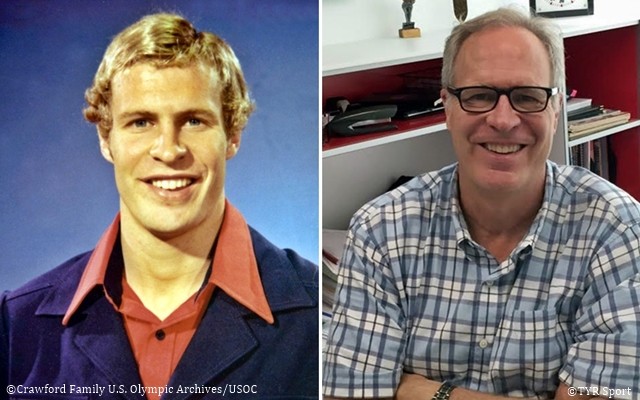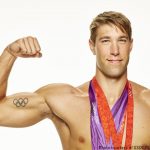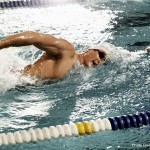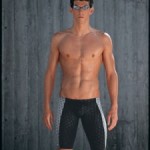
By Jae-Ha Kim
Tribune Content Agency
July 5, 2016
Olympic medalist Steve Furniss competed for the United States at the 1972 Olympics in Munich and also in Montreal four years later. A resident of Huntington Beach, California, he is a co-founder of the swimwear line TYR, which earned a place in pop culture by designing the iconic red swimsuits worn by the cast of “Baywatch.” At the Munich Games, Furniss was 19 and excited to be competing in Germany, but horrified to learn about the massacre of the members of the Israeli wrestling team. Now 63, he shares some of his memories of those Games and more.
Q. What was it like to experience all those different emotions at the 1972 Olympics at Munich?
A. My most vivid memories are of winning a medal for U.S. juxtaposed against what proved to be the first major high-profile global terrorist attack when the Israeli wrestling team was taken hostage by the Palestinian terrorist group Black September. I was fortunate enough to win a bronze medal in the 200-meter individual medley. I had several friends come to the Games. After my race, we went out and celebrated, arriving back in the late-morning hours. The next morning, I ran into a friend who was in an absolute panic as he explained that terrorists had taken the Israeli delegation hostage during the early-morning hours.
Q. What was security like back then in the Olympic Village?
A. When I came back the previous night, I had scaled the fence and there were no security guards or officials that I could see. The next day, I ran into a police barricade. I returned to my room and was confronted by two uniformed paramilitary police officers in the hallway, who shouted at me to halt. One had a rifle pointed at my head as they proceeded to frisk me. Fortunately, Mark Spitz stuck his head out and told the officers, “Nein, nein, American okay!” Mark was the athlete of the 1972 Games and was Jewish. The German authorities had placed significant security on him, given the gravity of the terrorists and general paranoia that was overtaking the Olympic Village, due to the ongoing negotiations for the hostages.
Q. What else do you remember about that night?
A. My friends had asked if I wanted to sleep in the van since it was rather long walk back to the village. I passed on their offer since space was cramped and I would have had to sleep in the drive’s front seat. Instead, I set off to walk back to the Olympic Village. It was after 3 a.m. Upon reaching the village, I realized that I would have to walk a considerable distance around the perimeter of the village to get to the main the entry gate. From there, I would have to traverse to the back of the village where I presently was in order to reach the building in which the U.S. Men’s Swim Team was housed. Though it was the early morning hours. I noted other athletes were scaling the fence, not wanting to walk the considerable distance to the front entry. Upon arriving home, I read a Time magazine account that detailed the movements of the Palestinian terrorists and their timeline for the attack. The terrorists were dressed as athletes and came over the same fence that I did at 4:15-4:30 a.m. in the morning. Reports I read stated they carried their weapons in athletic bags so as to draw attention from others. Re-tracing my steps, I realize I had scaled the fence in the same general area as they did, since the Israeli building was on the route to get to my building. Based on the Time magazine account, I preceded them by 30-45 minutes, which is a scary thought that one would be in such close proximity physically and in terms of time.
A couple nights later when one of the teams won a surprise medal in one of the track relays — I believe it was the French — who then celebrated by shooting off some celebratory rounds from the shooting team’s pistols, you cannot imagine the chaos that created as the officials thought it was the start of another terrorist act.
Q. Did you have time to see much of Germany?
A. During the 1972 Olympics, no, but I ended up working for Adidas in Strasbourg, France, and we lived there during the fall of 1976 and through the spring of 1977, just after getting married. During that time and subsequent years I spent considerable time in Europe on business and had the opportunity to visit various parts of Germany – Berlin, Bavaria, Munich. In fact, my wife and I just returned June 12th from celebrating our 40th wedding anniversary in which we visited our old apartment in Strasbourg and had lunch with an Alsatian couple that we have remained in contact with since living there.
Q. What other Olympic moments stand out for you?
A. I have had the good fortune to attend several Olympic Games since competing in Munich and Montreal: Los Angeles (1984), Atlanta (1996), Beijing (2008); London (2012). I have also had the honor of running the Olympic Torch Relay twice in 1984 and 2000. But competing on the 1976 Montreal Olympic team with my brother, Bruce, who is a double gold medalist, was probably the most memorable experience. In terms of attending as a spectator, I would rate Beijing as the most interesting overall. The facilities were incredible. I was in the swim stadium to witness Michael Phelps’ historic achievements. I probably enjoyed Atlanta more, though. I have the special memory of attending it with my son, Matt, who was just 13 at the time. I will never forget going to the beach volleyball women’s match where the Americans were playing against the Brazilians, who were the eventual gold medalists. We ended up as the only two in red-white-and-blue shirts in a virtual sea of yellow, since the Brazilian fans gave out free yellow Brazilian T-shirts, as long as you wore it during the match in support of their athletes. Needless to say, there were many takers for free T-shirts.
Q. What is your favorite vacation destination?
A. Hands down, West Maui. When you travel a lot for business, it is the ideal place for an ex-waterman to park it and enjoy its beaches and aquatic culture.
Q. To someone who was going there for the first time, what would you recommend that they do during their visit?
A. Other than take in some great meals from the sea that are caught daily, I would encourage those capable to do some snorkeling in Honolua Bay on Maui’s northwest shore. If you are not a water person, then I suggest taking the dual views of Lanai and Molokai (both islands seem so close from there) over lunch at the Gazebo in Napili. Bike ride down Haleakala Crater. Zip line in West Maui.
Q. What was the first trip you took as a child?
A. Family car trip with my three brothers from our home north of Seattle over to the Olympic Peninsula. The rain forest was so thick and mysterious to a 10-year-old kid. What’s not to love when you get to go somewhere you have not been before with adventure at every new turn?
Q. What’s the most important thing you’ve learned from your travels?
A. An appreciation for the world and its culture. Travel as an athlete provided me opportunities that I could not have afforded or have experienced otherwise. To have gone behind the Iron Curtain to Moscow in 1973 for the World Student Games changed my thinking politically, based on what I saw and experienced there. Americans, at that time, could not travel to Eastern Europe or Russia due to the Cold War.
Q. Where are your favorite weekend getaways?
A. We have a second home in La Quinta (near Coachella) so the desert is our favorite weekend getaway. Weather is terrific and even the extreme heat of the summer it has its attraction as it is not crowded plus the evening weather is perfect for being outside.
Q. When you go away, what are some of your must-have items?
A. Good reading material, duct tape, dual jack iPhone charger, plugin car phone charger, good hat, umbrella, good backpack.
Q. Have you traveled to a place that stood out so much that you felt compelled to incorporate it into your work?
A. Yes and no. I traveled to Austin on business and since I am in the swimming business, the people I was with took us to a natural pool that was maybe 300 yards long at Barton Springs, which is in the middle of the city. It was at night and was not very crowded and is an spectacular setting to go for swim. We could not, unfortunately, at the time, but I plan to visit in the future and swim there at night just before closing, as it seemed so serene and peaceful. I can imagine just shutting out all the sounds and cruising long strokes into the darkness.
Q. Where is the most romantic destination?
A. Grand Hotel Villa Serbelloni, Bellagio, Italy on Lake Como. Old school elegance.
Q. If you’ve ever gone away for the holidays, which was the best trip?
A. We are pretty traditional and typically do not like to travel during Christmas. We did it once and went down under to New Zealand and Australia, which was a great trip, but our kids missed being home for Christmas.
Q. Are there certain countries/cities that stand out as “swim countries”? When I was in Australia, it seemed that everyone and their grandmother was a very good swimmer!
A. Yes, several countries are known for their swimmers and swimming culture. Australia is certainly one of them, as virtually 90% of their entire country lives within very close proximity of the ocean. They are a water culture spawning many of the world’s top swimmers, surfers and other water sports related athletes. USA still tops them all as a swimming country, but in recent years the French have been quite strong along with Brits, Japanese and Russians. Look for other countries to break out as the Hungarians have always produced some strong swimmers (Katinka Hosszu and Lazlo Cseh); world record holder Sarah Sjostrom of Sweden who will battle Americans Dana Vollmer (2012 Gold Medalist) and Kelsi Worrell for gold in the 100 Butterfly.
Q. Where have you traveled to that most reminded you of home?
A. Spain.
Q. Where would you like to go that you have never been to before?
A. South Africa.
Q. What are your five favorite cities?
A. Strasbourg, France; San Sebastian, Spain; Washington, D.C.; Marbella, Spain; Christchurch, New Zealand.
Q. Have you traveled to Rio?
A. I have not. Rio is one of the few places I have not had the opportunity visit.
Q. What are your favorite restaurants?
A. Tres Amis Paia, Maui; Au Petite Bois Vert (Strasbourg, France) — this makes our list because of its Tarte flambee grantinee; Mama’s Fish House (Maui); Mayor de Migueloa Restarante (LaGuardia, Spain); Swiss House (Luzern); Hostellerie Chateau des Fines Roches (Chateauneuf-du-Pape, France); Gazebo, (Napili, Maui).
Q. What is your guilty pleasure when you’re on the road?
A. Eating all things we should not be eating including deserts.
Q. What are your favorite hotels?
A. Hotel Marques De Riscal in Elciego, Spain. Maria Christina in San Sebastian, Spain. Adelphi Hotel, Melbourne — makes the list due to the roof top pool that cantilevers over the street. The Artes Hotel in Barcelona.
Q. What kind of research do you do before you go away on a trip?
A. Extensive through both guides and on-line. Tap friends if they have been there as there are usually the best resource.
Q. What is your best vacation memory?
A. Our first trip to Europe with our kids was probably the most special as they were old enough to appreciate the antiquity and history of what we experienced.
Q. What would be your dream trip?
A. Just took it for our 40th anniversary: Venice, Bellagio, Lake Luzern, Strasbourg and Villeneuve les Avignon.
Q. What untapped destination should people know about?
A. “Labyrinth with Lanterns” under Buda Castle in Budapest, Hungary. Great fun for kids and young teenagers. The blowhole at mile marker 42 on the northwest shore of Maui. Worth the drive if one goes at right time of year and day (tides must be right) as it really spouts. Blackwater rafting Waitomo Caves on North Island (totally unique experience, but not for those that are claustrophobic). Singing Christmas carols on the banks of the Avon River holding a glow stick along with thousands of others in New Zealand. Red Poppy field in Villeron, France, when they are in bloom.
© 2016 JAE-HA KIM
DISTRIBUTED BY TRIBUNE CONTENT AGENCY, LLC.




